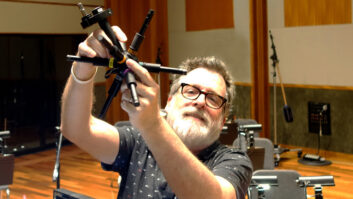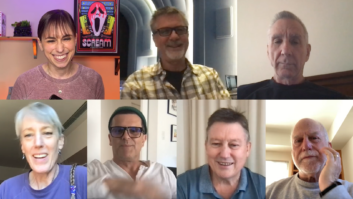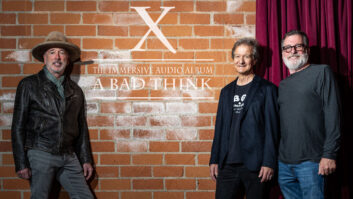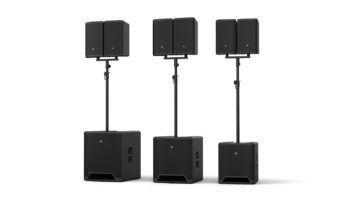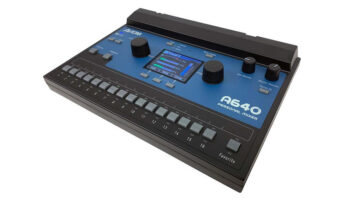Dave Way is no stranger to hot streaks. He’s had more than a few in his career, from his early days with kingpin hip hop producer Teddy Riley, to hit mixes for TLC, Whitney Houston, Babyface, Boyz II Men, Spice Girls, Bobby Brown, Michael Jackson and Toni Braxton, including Braxton’s Grammy-winning single “Breathe Again.” His latest hot streak places him once again at the top of the charts with mixes for back-to-back Number ones: Christina Aguilera’s “Genie in a Bottle” from her five-times Platinum CD, and “I Knew I Loved You” from Savage Garden’s latest Platinum endeavor, Affirmation. In addition, Way both recorded and mixed the CD that appeared on so many pop music critics’ Top 10 of 1999 lists, Macy Gray’s debut, on How Life Is.
It takes only a quick listen to note that the Aguilera, Gray and Savage Garden tunes all sound completely different from each other. obviously, Way isn’t the kind of mixer who churns out hits by imprinting his signature stamp on every project, and when you talk to him it becomes clear that this is no accident. He spends time and thought delving beneath the surface and takes great pride in helping to bring out just the right emotions and feel for each piece of music he’s involved with.
Way’s reputation for being an easygoing, all-around nice guy precedes him. In conversation he shows himself to be a true music lover, with a ready smile that evinces a quiet enthusiasm for the projects. It takes a bit of effort to make him talk about himself and his work, but, once primed, he has a lot to say. His ideas and theories on sound and the art of mixing are fully formed, the product of time spent listening, playing, studying and, of course, behind the console.
I first met with Way for this interview on a day when he was holed up at Larrabee North’s Studio one, mixing tracks for Quincy Jones’ latest pop project, Young Americans.
Congratulations on all your recent hits, and extra kudos for the Macy Gray record. I think it falls into that rare category of “What Is Hip?”
Yeah, I’m pretty proud of that one. You usually just come in for the mix these days; how did it happen that you recorded Macy’s CD? When [producer/manager] Andy Slater played me the demos, I was really floored-by Macy’s voice in particular. We started talking about what kind of record he wanted to make, and it turned out to be exactly the kind of R&B soul music, based on live players, that I’ve wanted to be a part of for a long time. He talked about Matt Chamberlain playing drums, and having Jon Brion come in, and it was like, “I’ve got to record this stuff-it’s going to be great!” Plus, because I’ve spent so many years now just mixing, with only little bits of recording here and there, I thought it would be good to get my chops back up, to make sure I haven’t lost anything. It was exciting, and it was a lot of fun, but it also made me realize how great just mixing is. [Laughs]
You’d forgotten how much work recording and mixing a whole album can be.
Recording and mixing…you get so inside of the record-it’s very intense. When you’re just mixing, it’s all been done. [Laughs] There’s a nice rough mix for you to listen to, and everybody’s excited for the song to be done at the end of the day. You do your thing, and a couple of days later you’re on to the next one. It’s creative, but it’s a lot easier on your mind and your psyche than doing the whole thing. At the same time, having done the whole Macy Gray record gives me a lot of satisfaction. But I don’t know if I can do that process more than once in a while. You must bring your mixer’s perspective to recording.
Yes, you’re constantly thinking about the mix as you’re recording-at least I was. So when it comes time to mix, you’re just trying to fine-tune the rough mixes. on Macy’s record, we did a lot of referencing to the roughs because they were really good. They were what everybody at the record company was excited about. We spent a long time seeing if we could make them a little bit better here and there, but basically we wanted to keep the raw quality that we had from them.
You worked on different consoles than the SSLs you’re used to.
We recorded almost all of it at Sunset Sound, and it was the first time I’d worked there. It was great-the API consoles they have sound amazing. We did most of the tracking with the drums in Studio Three, which is the little room in the back where Prince did Dirty Mind and some of his other earlier records. Then we moved to Studio one and did some mixing and some more overdubs. Then we went to A&M and did some mixing as well on a Neve.
From the start you had a sound in mind that you were going for.
Absolutely. As I understood it, we were looking for a Stevie Wonder sound, like from First Finale or Innervisions. That kind of dry, in-your-face, honest-sounding record, with people coming out of the speakers, rather than machines. And number one was to have Macy at the front of all of it, so that the focus was on her. We wanted her to be captured by this fun, almost family-like atmosphere going on around her. And I think that’s almost exactly what we got. What did you do to accomplish that? Number one, we used hardly any digital gear, no digital reverbs…
In tracking?
In mixing, too. When it came time to mix, we used plates and chambers and we set up some mics and an amp out in the room at A&M’s Studio A, the big live room. We used a lot of compression to make things sound like they had a lot of room on them, and we really tried to stay away from anything digital, anything that would take away from the warm, analog, not-so-state-of-the-art sound. We wanted to make a record as if it had been done in 1973.
It doesn’t sound like 1973, though. It sounds totally contemporary and very cool.
The modern stuff comes from DJ Kilu, who did scratching and from loops. Rami [Jaffee] used a Casio keyboard that he’d run through an Echoplex and this weird Univox filter and all kinds of other crazy contraptions. We’d just put a mic on the amp. So from the source there were some digital links in the chain, but outside of that it was pretty much all microphones and tape.
Let’s go back in time. How did you learn engineering?
I went to school-Berklee College of Music in Boston.
To study music?
No, engineering. But when you’re at Berklee, you’re a musician. For about the first two years, you don’t even step into a studio. You’re taking theory courses on the studio side and practicing your instrument-taking harmony and arranging classes. Because, if you want to get a degree like I did, a Bachelor of Music, you’ve got to pass your proficiencies on whatever your instrument is. My instrument, when I was there, was bass.
How did you even know that there was such a thing as a recording engineer?
I grew up listening to The Beatles and Stevie Wonder. I spent years listening to all of their records with headphones on, dissecting them and listening to every note. It’s hard not to be aware of the engineering and production side of music when you’re listening to “I Am the Walrus” or something like that.
And, growing up in bands, I was making demos. I had this 11/44-inch Sony tape machine that we used-it actually sounded really good. I remember recording, with this little Radio Shack mixer, our version of The Eagles’ “Best of My Love” on that 11/44-inch machine, and when we played it back it sounded great. Just the sound of the tape saturation and everything else-it was amazing because you sounded 100 times better than you did in real life due to the medium you were recording on.
Then, after school…
I sent out my resume and ended up at the Hit Factory for a few months, and then went to work across the street from it at this little one-room studio called SoundWorks. Shep Pettibone and Teddy Riley were working there all the time, just at the start of when they were becoming well-known.
For a year, I worked a lot assisting and doing engineering for both of them. Then, stroke of luck, Teddy asked me to do a mix with him one day. He liked it, and I kept working for him. I joined up with Teddy just as his career was starting to skyrocket. I learned so much watching him; he’s just an amazing sponge of creativity. The way that he was making hip hop/ R&B/new jack swing records then was so revolutionary. It’s the way records are commonly made now, but then it was making everybody sit up and look.
For somebody to be sampling these little bits of James Brown and all kinds of snare drums and kick drums and vocal samples and playing them like a drum machine…He really was making music in a different way, and he influenced everybody. He changed the face of R&B music.
Bass is key to most songs, especially to the R&B-based pop music you often work on. Do you have any theories about how to make it work properly?
When I think of bass I think of length, like how long a note should be. Because you can make a note longer by boosting 20 or 30 Hz. Those frequencies are so big they ring out in the room longer and make the note actually longer. Sometimes you want something to be really long and to hang over, sometimes you want it to be tight and clipped. So, you might have to clean up the bass and take out some of that 20 to 30 Hz to make it tighter. After that, I’m looking at the detail and the high end of it to make sure that it’s poking through. If you are listening on an Auratone or something that doesn’t have a lot of bass in it, can you still hear what the bass is doing?
Sometimes, on R&B records, the bass is like a Minimoog thing, where it’s almost all low end and fundamental; there aren’t a lot of harmonics to it. That’s fine when you’re playing it on the big system, but when it comes time to listen on the Auratone, you’ve got to come up with some tricks to make it audible on the small speaker. That might include splitting it off and trying to find where you can get the attack on it, then compressing and EQ’ing that and adding it in on top.
So you spend time listening on a single Auratone?
Sometimes, or I’ll listen on the Studer speaker.
What are your main monitors?
Generally, here at Larrabee, I’ll tend to listen to the big speakers more, because they’re really good, but I do listen to them at a pretty low level. At other studios, I just work on the near-fields.
I have a pair of Tannoy System 8s that I’ve had for a long time that I love, and just recently I’ve gone back to using the regular [Yamaha] NS-10 studio monitors. Before, I had a pair that had a custom crossover in them. I like the NS-10 studios, because they’re not quite as bright. I like to have a nice full bass and a good amount of midrange-but not to be too hyped on the high end.
I’m constantly trying to listen to speakers. At home, I’ve got a pair of NHTs that I really love. I went to a hi-fi store and heard the NHTs with a Sony amp. They sounded great-I love to listen to music on them. They’ve just started making some studio monitors.Yours are high-end consumer monitors.Yeah. They’ve got domed tweeters and a small midrange speaker, about 5 or 6 inches, and a side-firing low speaker. It’s like a sub that comes out the side rather than the front. It adds a different kind of spaciousness that fills up the room in a very nice way. I love taking my CDs from the studio home and listening on them.
I love speakers, and I try to listen to a lot of them. I have a pair of KRK E7s that sometimes I like, sometimes I don’t like. Recently I’ve also listened to the E8s with a subwoofer and I’m starting to like them.
You’ve got to be careful about getting new monitors. You’ve got to break them in and get to know them before you start to rely on them. So, at this point, I’ve also got these little Bose Freestyle speakers that I got turned on to at La Face by Barney Perkins, the engineer there. They still sell them; they sound like a little boom box with a surprising amount of bass coming out of them. They do have a really hyped high end, but between them and the NS-10s and the Tannoys, I feel like I’ve got all the bases covered.
You have all of them set up in the control room when you’re mixing?
Yes. I do a lot of switching between them, then listening off the Studer. Then, like I said, here at Larrabee I use the big monitors a lot, and then I go out to the car. I always take a CD out to the car before I put it down, and then I play it at home. [Laughs] If I can’t figure it out after all those speakers…
Do you always leave a mix up overnight so you can take it home and check it out?
Lately I’ve been really appreciating the value of that extra half a day on the second day-that extra two or three hours in the morning after you’ve listened at home and listened in the car and slept on it. To be able to make it that extra 5 or 10 percent better really does make a difference. Sometimes, of course, it sounds great, and you come in the next day and just print it, but it’s nice to have the luxury to know you’ve got it right.
“Genie in a Bottle” sounds present and punchy, but avoids getting attention by being superbright.
The superbright thing doesn’t work for me when I’m trying to make something hard and punchy. Superbright works when you want to make something sound nice and pretty. So, on something like “Genie in a Bottle,” too much brightness can actually take away from the attitude.
I try to think of frequencies and mixes, in general, on emotional levels. What kind of feelings and emotions are you trying to bring out of this song or this artist? That was a song that we wanted to be hard and fun and to have it catch your ear from the very first intro.
You think about frequencies in terms of emotion?
Absolutely. For instance, bass frequencies seem to fill me up with warmth, and they kind of resonate down here [points to stomach]. Ultrahigh frequencies translate to me in terms of pretty and sweet. I don’t think it’s a coincidence that we say an EQ that has high end on it sounds sweet. If you’re mixing a ballad and the lyrics have something kind of naive or pretty about them, you might want to kind of accentuate those frequencies.
Whereas, with a warm ballad that’s maybe a little serious, I would tend to steer clear of those frequencies that make it too pretty. Then, for me, midrange frequencies equal a more jarring kind of energy. It equals “bold” in a big way, and you use it if you want something to really grab your attention; if you want the artist to come across saying, “This is how it is!” you want to make sure the midrange is screaming to you, saying, “Hey, listen to me!”
Now, the song “I Knew I Loved You” [by Savage Garden] is not one of those songs. That’s a sweet song. So if you were to compare that song with “Genie in a Bottle,” you would definitely hear differences between the high-end information on both of them. There’s also probably a little more bass on the Savage Garden song. Bass on a funky track like “Genie” can have a lot of energy also, but it’s not ultralow. The ultralow stuff would be more on Savage Garden because it would fill you up with some warmth.
That’s why I don’t always try to make every mix and every song sound the same frequency-wise-they’re not trying to say the same thing, and they shouldn’t sound like it. I’m trying help get across what they are trying to say and to pick the frequencies and effects that work for that.
Anything unusual happen during the mix for “Genie in a Bottle”?
Well, one interesting thing happened after we’d done a mix and listened-all of us-and agreed that there was something in the rough mix that was missing from the final. We determined that it was because the rough mix was all done in Pro Tools, all-digital. But, the night before we mixed, they’d dumped everything onto 2-inch tape for the mix, and that had changed the sound. Particularly the drums and background vocals, which were softened somewhat-having lost those transients going to tape it was hard to get them back. So, we ended up bringing the Pro Tools rig back down and taking most of the drums and some of the vocals right off of it, and the rest of it off 2-inch. That’s what ended up in the final mix. That leads us to the eternal question, digital or analog?
I embrace all. Like, for Macy Gray, I wouldn’t have picked anything but 2-inch tape. [Laughs] Well, maybe I might have picked 2-inch 16-track or 1-inch 8-track if we had those options. on that record, we mixed to both 11/42-inch and DAT with a DB Technologies converter at the front, and for the mixes, we did at A&M we used the custom converters that they have there, which sound really good. I’d say on probably at least half of the songs we mastered from the DATs. We’d listen to both, and one format would work better for some particular song.
I’ve got to say, though, that recently I’ve been mixing more directly off Pro Tools; in the last few months, probably 60 percent of the things I’ve mixed have been right off 24-bit Pro Tools and they’ve sounded great. Especially coming through an SSL 9000 console. Don’t you ever worry that things may end up sounding too much the same if everybody ends up recording in the same format, i.e., Pro Tools?
You still have control over what goes in on the front end-you’re free to manipulate as much as you want. It’s not going to make things sound more “all the same” than when everybody was putting everything on 2-inch 24-track. Plus, the console still makes a lot of difference-more, in my opinion, than the recording format.
As a busy mixer, how do you avoid doing the same things all the time, thus, ending up with the same sounds? It’s easy. I don’t use the same gear all the time, and I constantly try new things. Like lately, I’ve been using a Pendulum Audio compressor that’s really pretty good. There’s a certain sound to all these things-an EMT 250 sounds different than an AMS RMX. They might both have a long 3.5 reverb time, but they have different qualities, and depending on whether I want something that jumps out of the track or sinks into it, I’ll choose one or the other.
I hope that all my mixes don’t sound the same, because if they did, I’d feel like I hadn’t done my job. Macy wouldn’t have sounded right like Christina. They’re two totally different artists-why should I impose what I want to say on what they want to say?
In a second conversation I prevailed upon Way to get specific about what he was doing on a few channels of the mix he was doing for British pop sensations S Club 7. He demurred at first, insisting that the mix was too simple to be of interest, but his basic good nature won out when I persisted.
Let’s take a look at what you’re doing on the bass.
This is definitely a single-sounding mix; it’s got a funky beat with a bass that primarily moves around with the kick drum. Also, the bass is more staccato in the verses and legato in the choruses, on the same channel, with basically the same notes and chord progressions through the verses and the choruses.
So, I did have to do some things in order to make it more dynamic between the verse and the chorus. I did some mutes, on both the bass and the kick drum, to help the overall dynamic of the song.
On the bass, I tried different compressors, like the Tube-Tech, which I use a lot, but when I compared it with the uncompressed sound I preferred it uncompressed. I did the same thing with a Motown EQ that I often use to put a lot of low, low stuff in, but it didn’t sound any better either. I always compare to how the signal is originally, and if it’s not better after fudging with it, I’ll go back to the original sound.
I ended up with just a little bit of board compression on the bass. I do have a good amount of EQ compared to what I normally put on- mostly accentuating midrange and upper stuff. I also added some Pod [Line-6] distortion to bring out a little more harmonics and make it a little more buzzy.
You have that on an insert?
No, it’s on a bus, and I’m mixing it in. It really seemed to jump out of the track when I added the Pod on top of it. It’s the kind of thing you don’t necessarily hear in the track but you feel it, and all of a sudden it seems to have more presence without having to EQ the midrange on it. That’s nothing new-a lot of people do it.
Yeah, I’m seeing Pods in every control room lately.
Guilty as charged.
Okay, drums.
On the kick drum, I’ve got a 550A on the insert, just to give it a little more knock. I like those, because they’re particularly hard-sounding, almost shiny. I’m boosting 2 dB at 5k, 2 dB at 1.5, then taking out a little at 300 [Hz], and the highshelf filter is in.
There’s also a little bit of an enhancing reverb on it-a very, very, short room from the [Eventide] orville, one of my favorite boxes these days. It’s so short it’s actually more like a chorus.
Backgrounds.This song has a nice airy feel; the chorus is mainly background vocals that are kind of light and breathy, fairly sweet on top of this funky beat. I tried to go with that and put this airy reverb on the background vocals in the chorus to exaggerate that quality in the vocals, using the orville program called Ghost Air. I also brightened them up considerably. There’s also a judicious amount of delay on the vocals, [Laughs] in keeping with the British approach to mixing, which maybe has a little more reverb and delays than I would normally use. Because they are British and also I’d heard tracks from their last album and from this one, I think that sound is part of their appeal that I don’t want to change. -Maureen Droney
Christina Aguilera: “Genie in a Bottle” and “What a Girl Wants”
Fiona Apple: “Across the Universe,” Pleasantville soundtrack
Babyface: “When Can I See you Again?” and “For the Cool in You”
Bell Biv DeVoe: “Something in Your Eyes”
Boyz II Men: “Motown Philly”
Brandy: “Tomorrow” and “Angel in Disguise”
Toni Braxton: “Breathe Again,” “Seven Whole Days” and “You Mean the World to Me”
Bobby Brown: “Humpin’ Around”
Macy Gray: on How Life Is
Guy: The Future, “She’s Just a Fantasy,” “Do Me Right,” “I Want to Get With You”
Heavy D: “Now That We Found Love” and “Is it Good For You”
Whitney Houston: “Somebody Bigger,” The Preacher’s Wife soundtrack and “Queen of the Night,” The Bodyguard soundtrack Michael Jackson: “Blood on the Dancefloor,” “Super Fly Sister,” “Ghost,” “Scream (remix),” “Jam,” “In the Closet” and “Remember the Time”
Luis Miguel: “Sol Arena y Mar”
Aaron Neville: “Use Me”
Stevie Nicks: Forthcoming LP
CeCe Penniston: “I’m in the Mood”
Savage Garden: Affirmation
Soul II Soul: “Keep on Movin'”
Spice Girls: Five songs from Spice
TLC: “Red Light Special,” “Diggin’ on You,” “Get It Up,” “Ain’t Too Proud to Beg,” “Baby, Baby, Baby” and “What About Your Friends”
The Wallflowers: Various tracks
The Winans: “It’s Time”
Stevie Wonder: “To Feel the Fire” and forthcoming, “overjoyed”
X: “The Crystal Ship,” The X-Files soundtrack and “Wild Thing,” Major League II soundtrack

